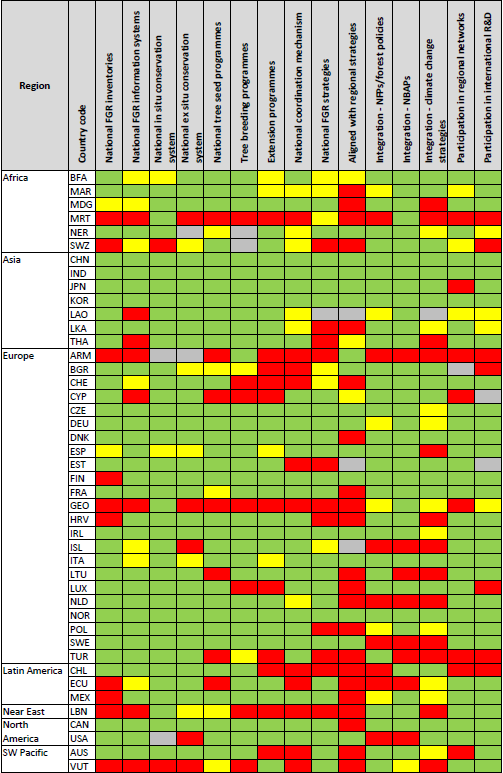First implementation report
Through Circular State Letter C/CBD-7 of 22 May 2017, FAO invited Members to submit their country progress reports on the implementation of the Global Plan of Action by 31 December 2017. Countries could report through a dedicated online reporting system by completing the questionnaire made available on the Open Foris platform. To facilitate the answering of species-specific questions, the list of species reported earlier for The State of the World’s Forest Genetic Resources was revised to reflect recent changes in taxonomy and to exclude minor shrub species that may be considered only marginally as “forest genetic resources”. The updated list, including approximately 6 600 species, was incorporated into the online reporting system.
A total of 90 National Focal Points (NFPs) were provided with a username and a password for accessing the online reporting system. During the reporting process, the Secretariat provided, on request, technical support to the NFPs on using the online reporting system. The NFPs could also add species to the list of species in the reporting template by informing the Secretariat. The completed online questionnaire was considered as the country progress report. A total of 44 countries submitted their progress reports for the preparation of the First Implementation Report
List of countries (44) that submitted their progress reports (as of October 2018)
- Africa (6): Burkina Faso, Eswatini, Morocco, Madagascar, Mauritania, Niger
- Asia (7): China, India, Japan, Republic of Korea, Lao People’s Democratic Republic, Sri Lanka, Thailand
- Europe (23): Armenia, Bulgaria, Croatia, Cyprus, Czechia, Denmark, Estonia, Finland, France, Georgia, Germany, Iceland, Ireland, Italy, Lithuania, Luxembourg, Netherlands, Norway, Poland, Spain, Sweden, Switzerland, Turkey
- Latin America and the Caribbean (3): Chile, Ecuador, Mexico
- Near East (1): Lebanon
- North America (2): Canada, United States of America
- South West Pacific (2): Australia, Vanuatu
Of the regional networks on forest genetic resources and relevant international organizations, reports were received from the European Forest Genetic Resources Programme (EUFORGEN) and Bioversity International on their contributions to the implementation of the Global Plan of Action. The report of Bioversity International also included some activities it had carried out in collaboration with the Asia Pacific Forest Genetic Resources Programme (APFORGEN), the Sub-Saharan Forest Genetic Resources Programme (SAFORGEN) and the Latin America Forest Genetic Resources Network (LAFORGEN).
In February 2019, the Commission on Genetic Resources for Food and Agriculture took note of the First Implementation Report and invited countries to continue implementing the Global Plan of Action. It also encouraged them to address the findings of the report, as appropriate. The detailed First Implementation Report is available here and some findings of the report are summarized below.
As only 44 submitted their progress reports, the findings of the report do not allow making comprehensive conclusions on the progress made by countries in implementing the Global Plan of Action. However, some observations can be made based on the information and data submitted by the 44 reporting countries.
Targets A.1, A.2, A.3, A.4, and B.4 consist of a total of 15 action points for each country to respond to the Global Plan of Action. At the global level, 67 percent of these action points have been achieved or put in place, and a further 10 percent of the actions have been initiated, but not yet completed, by the reporting countries (see the table below). Action points that have not been initiated nor put in place account for 21 percent. For 2 percent of the action points the reporting countries did not have information available to answer the questions. Only four of the 44 reporting countries have achieved all 15 action points.
Nine countries reported achieving action points after 2013 when the Global Plan of Action was adopted and a total of 28 countries reported that efforts have been initiated to achieve them. These findings suggest that specific efforts have been made, as a response to the Global Plan of Action, to enhance the conservation, use and development of forest genetic resources at national level. The situation is relatively good in many of the reporting countries in terms of having various mechanisms, programmes and strategies on forest genetic resou
Overview of the 15 action points based on Targets A.1-4 and B.4 in the 44 reporting countries
Colour codes: green – achieved; yellow – initiated but not yet completed; red – not achieved; grey – no information available

Under Targets B.1, B.2 and B.3 related to the characterization, conservation, use and development of forest genetic resources, a total of 1 145 tree and other woody plant species (including hybrids) were mentioned in the 44 country progress reports. Up-to-date national distribution range is available for 808 species in these countries, and 731 and 393 species have been characterized based on non-molecular and molecular information, respectively. In situ and ex situ conservation programmes include 568 and 647 species, respectively. The reported national tree seed programmes include 531 species to produce forest reproductive material and the reported tree breeding programmes focus on 288 species.
